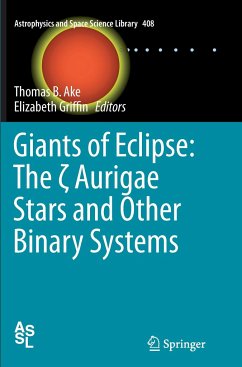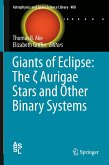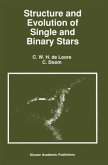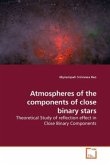The zeta Aurigae stars are the rare but illustrious sub-group of binary stars that undergo the dramatic phenomenon of "chromospheric eclipse". This book provides detailed descriptions of the ten known systems, illustrates them richly with examples of new spectra, and places them in the context of stellar structure and evolution.
Comprised of a large cool giant plus a small hot dwarf, these key eclipsing binaries reveal fascinating changes in their spectra very close to total eclipse, when the hot star shines through differing heights of the "chromosphere", or outer atmosphere, of the giant star. The phenomenon provides astrophysics with the means of analyzing the outer atmosphere of a giant star and how that material is shed into space. The physics of these critical events can be explained qualitatively, but it is more challenging to extract hard facts from the observations, and tough to model the chromosphere in any detail.
The book offers current thinking on mechanismsfor heating a star's chromosphere and on how a star loses mass, and relates this science synergistically to studies of other stars and binaries, and to the increasing relevance of contributions from new techniques in interferometry and asteroseismology. It also includes a detailed discussion of the enigmatic star epsilon Aurigae, which had recently undergone one of its very infrequent and very baffling eclipses. Though not a zeta Aurigae system, epsilon Aurigae is a true "Giant" among eclipsing stars.
The 7 chapters of this book, written by a group of experts, have been carefully edited to form a coherent volume that offers a thorough overview of the subject to both professional and student.
Comprised of a large cool giant plus a small hot dwarf, these key eclipsing binaries reveal fascinating changes in their spectra very close to total eclipse, when the hot star shines through differing heights of the "chromosphere", or outer atmosphere, of the giant star. The phenomenon provides astrophysics with the means of analyzing the outer atmosphere of a giant star and how that material is shed into space. The physics of these critical events can be explained qualitatively, but it is more challenging to extract hard facts from the observations, and tough to model the chromosphere in any detail.
The book offers current thinking on mechanismsfor heating a star's chromosphere and on how a star loses mass, and relates this science synergistically to studies of other stars and binaries, and to the increasing relevance of contributions from new techniques in interferometry and asteroseismology. It also includes a detailed discussion of the enigmatic star epsilon Aurigae, which had recently undergone one of its very infrequent and very baffling eclipses. Though not a zeta Aurigae system, epsilon Aurigae is a true "Giant" among eclipsing stars.
The 7 chapters of this book, written by a group of experts, have been carefully edited to form a coherent volume that offers a thorough overview of the subject to both professional and student.
"Thomas Ake and Elizabeth Griffin invited concise but comprehensive reviews of the important aspects of the observation, analysis, and theory of these uncommon binary systems that offer up rare opportunities for probing the outer atmosphere of a cool giant or supergiant when its hot companion is occulted. ... this excellent volume serves as the gateway to the study of these stars for years to come." (Harold A. McAlister, The Observatory, Vol. 136 (1253), August, 2016)








